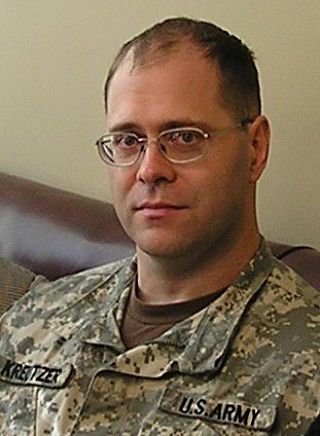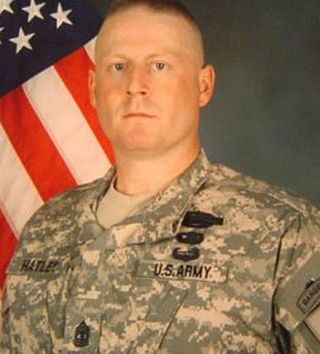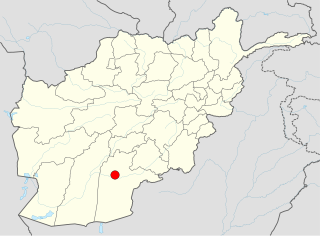
Fort Liberty, formerly Fort Bragg, is a military installation of the United States Army in North Carolina, and is one of the largest military installations in the world by population, with over 52,000 military personnel. The military reservation is located within Cumberland and Hoke counties, and borders the towns of Fayetteville, Spring Lake, and Southern Pines.

Fragging is the deliberate or attempted killing of a soldier, usually a superior, by a fellow soldier. U.S. military personnel coined the word during the Vietnam War, when such killings were most often committed or attempted with a fragmentation grenade, to make it appear that the killing was accidental or during combat with the enemy. The term fragging now encompasses any deliberate killing of military colleagues.

The United States Disciplinary Barracks (USDB), colloquially known as Leavenworth, is a military correctional facility located on Fort Leavenworth, a United States Army post in Kansas. It is one of two major prisons built on Fort Leavenworth property, the other is the military Midwest Joint Regional Correctional Facility, which opened on 5 October 2010. It reports to the United States Army Corrections Command and its commandant usually holds the rank of colonel.
The Biscari massacre was a war crime committed by members of the United States Army during World War II. It refers to two incidents in which U.S. soldiers were involved in killing 71 unarmed Italian and 2 German prisoners-of-war at the Regia Aeronautica's 504 air base in Santo Pietro, a small village near Caltagirone, southern Sicily, Italy on 14 July 1943.

William J. Kreutzer Jr. is a former United States Army soldier who was convicted of killing one officer and wounding 18 other soldiers when he opened fire on a physical training formation on October 27, 1995, at Fort Bragg, North Carolina. Kreutzer was sentenced to death, but his sentence was later commuted to life in prison by the Army Court of Criminal Appeals in connection with concerns regarding mental illness.

Russell Adam Burnham, is an American business owner, Physician Assistant and U.S. Army veteran. Burnham was recognized as the 2003 U.S. Army Soldier of the Year, 2007 U.S. Army Medical Corps NCO of the Year, and is an Eagle Scout. He is the great-grandson of Frederick Russell Burnham (1861–1947), recipient of the Distinguished Service Order, and famous American scout and world-traveling adventurer who helped inspire the founding of the international Scouting Movement.

The Haditha massacre was a series of killings on November 19, 2005, in which a group of United States Marines killed 24 unarmed Iraqi civilians. The killings occurred in Haditha, a city in Iraq's western province of Al Anbar. Among the dead were men, women, elderly people and children as young as 1, who were shot multiple times at close range while unarmed. The ensuing massacre took place after an improvised explosive device exploded near a convoy, killing a lance corporal and severely injuring two other marines. The immediate reaction was to seize 5 men in a nearby taxi and execute them on the street.
The Mahmudiyah rape and killings were a series of war crimes committed by five United States Army soldiers during the U.S. occupation of Iraq, involving the gang-rape and murder of 14-year-old Iraqi girl Abeer Qassim Hamza al-Janabi and the murder of her family on March 12, 2006. It occurred in the family's house to the southwest of Yusufiyah, a village to the west of the town of Al-Mahmudiyah, Iraq. Other members of al-Janabi's family murdered by American soldiers included her 34-year-old mother Fakhriyah Taha Muhasen, 45-year-old father Qassim Hamza Raheem, and 6-year-old sister Hadeel Qassim Hamza al-Janabi. The two remaining survivors of the family, 9-year-old brother Ahmed and 11-year-old brother Mohammed, were at school during the massacre and orphaned by the event.

Michael (Stewart) Waddington is an American criminal defense lawyer specializing in court-martial cases, war crimes, and other serious felonies. He defended Sgt. Alan Driver, accused of abusing detainees, and Specialist Hunsaker in the Operation Iron Triangle Case.
The Nisour Square massacre occurred on September 16, 2007, when employees of Blackwater Security Consulting, a private military company contracted by the US government to provide security services in Iraq, shot at Iraqi civilians, killing 17 and injuring 20 in Nisour Square, Baghdad, while escorting a U.S. embassy convoy. The killings outraged Iraqis and strained relations between Iraq and the United States. In 2014, four Blackwater employees were tried and convicted in U.S. federal court; one of murder, and the other three of manslaughter and firearms charges; all four convicted were controversially pardoned by President Donald Trump in December 2020. U.N. experts said the pardons "violate U.S. obligations under international law and more broadly undermine humanitarian law and human rights at a global level”.
United States war crimes are violations of the law of war which were committed by members of the United States Armed Forces after the signing of the Hague Conventions of 1899 and 1907 and the signing of the Geneva Conventions. The United States prosecutes offenders through the War Crimes Act of 1996 as well as through articles in the Uniform Code of Military Justice. The United States signed the 1999 Rome Statute but it never ratified the treaty, taking the position that the International Criminal Court (ICC) lacks fundamental checks and balances. The American Service-Members' Protection Act of 2002 further limited US involvement with the ICC. The ICC was conceived as a body to try war crimes when states do not have effective or reliable processes to investigate for themselves. The United States says that it has investigated many of the accusations alleged by the ICC prosecutors as having occurred in Afghanistan, and thus does not accept ICC jurisdiction over its nationals.
The Military Extraterritorial Jurisdiction Act (MEJA) is a law intended to place military contractors under U.S. law. The law was used to prosecute former Marine Corps Sgt. Jose Luis Nazario, Jr. for the killing of unarmed Iraqi detainees, though he was ultimately acquitted.

John E. Hatley is a former first sergeant who was prosecuted by the United States Army in 2008 for murdering four Iraqi detainees near Baghdad, Iraq in 2006. He was convicted in 2009 and sentenced to life in prison at the Fort Leavenworth Disciplinary Barracks. He was released on parole in October 2020. Hatley is colloquially associated with a group of US military personnel convicted of war crimes known as the Leavenworth 10.

Nidal Malik Hasan is a Palestinian-American former United States Army major, physician and mass murderer convicted of killing thirteen people and injuring more than 30 others in the Fort Hood mass shooting on November 5, 2009. Hasan, an Army Medical Corps psychiatrist, admitted to the shootings at his court-martial in August 2013.

Michael Chase Behenna is a former United States Army First Lieutenant who was convicted of the 2008 murder of Ali Mansur Mohamed during the occupation of Iraq. Behenna is colloquially associated with a group of U.S. military personnel convicted of war crimes known as the Leavenworth 10. He was sentenced to 25 years imprisonment, which was later reduced to 15 years, and served his sentence in the United States Disciplinary Barracks on Fort Leavenworth, a United States Army post in Kansas. He was granted parole on March 14, 2014, after serving less than five years of his sentence. Since his release from prison he has worked as a farmhand. On May 6, 2019, Behenna received a pardon from President Donald Trump.

On July 12, 2007, a series of air-to-ground attacks were conducted by a team of two U.S. AH-64 Apache helicopters in Al-Amin al-Thaniyah, New Baghdad, during the Iraqi insurgency which followed the invasion of Iraq. On April 5, 2010, the attacks received worldwide coverage and controversy following the release of 39 minutes of classified gunsight footage by WikiLeaks. The video, which WikiLeaks titled Collateral Murder, showed the crew firing on a group of people and killing several of them, including two Reuters journalists, and then laughing at some of the casualties, all of whom were civilians. An anonymous U.S. military official confirmed the authenticity of the footage, which provoked global discussion on the legality and morality of the attacks.
United States v. Hasan K. Akbar was the court-martial of a United States Army soldier for a premeditated attack in the early morning hours of March 23, 2003, at Camp Pennsylvania, Kuwait, during the start of the United States invasion of Iraq.

The Kandahar massacre, also called the Panjwai massacre, was a mass murder that occurred in the early hours of 11 March 2012, when United States Army Staff Sergeant Robert Bales murdered 16 Afghan civilians and wounded six others in the Panjwayi District of Kandahar Province, Afghanistan. Nine of his victims were children, and 11 of the dead were from the same family. Some of the corpses were partially burned. Bales was taken into custody later that morning when he told authorities, "I did it".

Robert Bales is an American mass murderer and former Army sniper who fatally shot or stabbed 16 Afghan civilians in a mass murder in Panjwayi District, Kandahar Province, Afghanistan, on March 11, 2012 – an event known as the Kandahar massacre.
Derrick Miller is a former US Army National Guardsman sergeant who was sentenced in 2011 to life in prison with the chance of parole for the murder of an Afghan civilian during a battlefield interrogation. Miller is colloquially associated with a group of U.S. military personnel convicted of war crimes known as the Leavenworth 10. After being incarcerated for eight years, Miller was granted parole and released in 2019. He currently serves as the Executive Director of the Justice for Warriors Caucus and Military Adviser to Texas Republican U.S. Representative Louie Gohmert.














